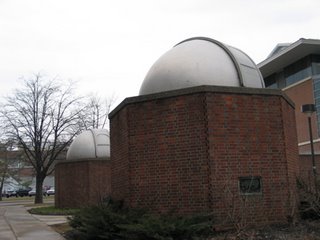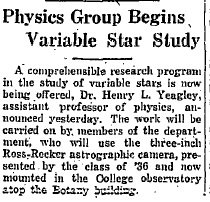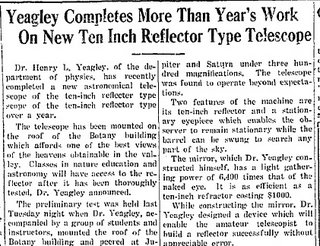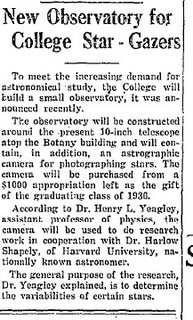The Old Domes @ PSU

This story has been percolating in my own dome for about a year now. The picture above shows two old, small brick buildings with observatory domes on top of them. These are located between Eisenhower Parking Deck (#49) and the MBNA Career Services Building (#110) on this map. Oh yeah, and in the real world, on Penn State's University Park campus. The parking deck and the MBNA building are both fairly tall, so there is
Since I am often found on the rare clear Friday nights in this town stargazing on the roof of Davey Lab, I have been asked many times when the old domes were built, if there are telescopes inside them, and why they are in such a strange location. My answer in the past: I have no idea. It is fairly obvious that the domes are old, and since no one that I know has ever been inside them, I assume that the last time they were used to house telescopes was probably decades ago. Since they have been mothballed so long, tall buildings grew up around them, and they lost their view of the sky. Of course, the next mystery is then, why leave them there and not tear them down?
During the summer of 2005, the answer to all of these questions dropped by the roof to do some stargazing for himself. A gentleman told me that his grandfather used to teach telescope making at Penn State, and the domes were a pet project of his during the 1930s. It turns out that Richard is an avid genealogist when he is not otherwised occupied trying to suss out the origin of hot subdwarfs, and knowing only the name of the visitor to the roof, we tracked down his grandfather -- Dr. Henry L. Yeagley of the Department of Physics.
The Penn State Libraries have put up a searchable archive of the historical issues of the Collegian, and there are a number of articles about Dr. Yeagley's plan to put nine domes in a semi-circle, each filled with a ten-inch reflector built in his class. I don't think the other seven were ever built.
At the bottom of this post are a few clips (I would have provided links, but I can't for the life of me figure out how to get a static link to the individual newspapers). I also couldn't figure out a nicer way to format this post.
Two more points, and then I'll wrap this up.
The articles give clues to the answer to my question -- why weren't they torn down at some point? The class gifts of the 1930s include both the 10 inch telescope that was apparently on top of Botany (although the table here says Buckhout), and the domes. Presumably, one does not tear down class gifts.
Lastly, it is very interesting to note that astronomy and telescope making were being taught in the 1930s, because from what I've been told, the Department of Astronomy & Astrophysics was only formed in the 1970s, and very little information about the teaching of astronomy at Penn State prior to the 1970s is known among the current members of the department (or at least, if they know, they don't often share this knowledge).
I'd love to know what happened to Dr. Yeagley's telescopes...
Update:I poked around a bit and found some additional articles about Dr. Yeagley, and I turned up some more interesting information about his role in Penn State history. In his obituary in the PSU Science Journal, they mention that he founded the Department of Astronomy at Penn State. Given that he retired in 1958, this seems to indicate the department has been around longer than believed by most of us currently employed there. Moreover, in the Historical Collegian, it says that Dr. Yeagley had a planetarium in room 216 Osmond as early as the early 1950s. We have a planetarium now and we all believe that it is ~1960s technology, but maybe it is Dr. Yeagley's projector? Again, this would indicate it is older than any of us believe. After retiring from Penn State, Dr. Yeagley went to Dickinson College in Carlisle, and this page indicates he designed the planetarium that they refer to on this page as the Bonisteel-Yeagley planetarium.
Although this has nothing to do with astronomy, telescopes, domes, or planetaria, as a last note it is interesting to me that what seems to be his greatest research accomplishment was the study of the physics behind bird navigation. There are several articles in the historical Collegian archives about him raising ducks on the roof of Osmond Lab.






0 Comments:
Post a Comment
<< Home